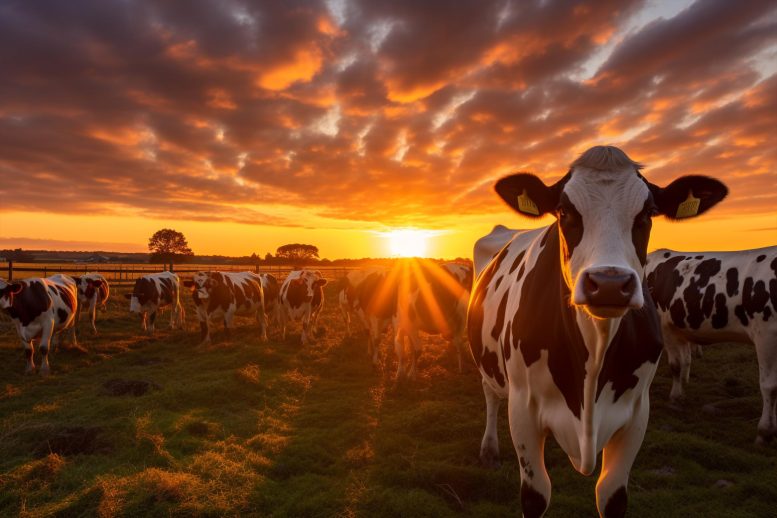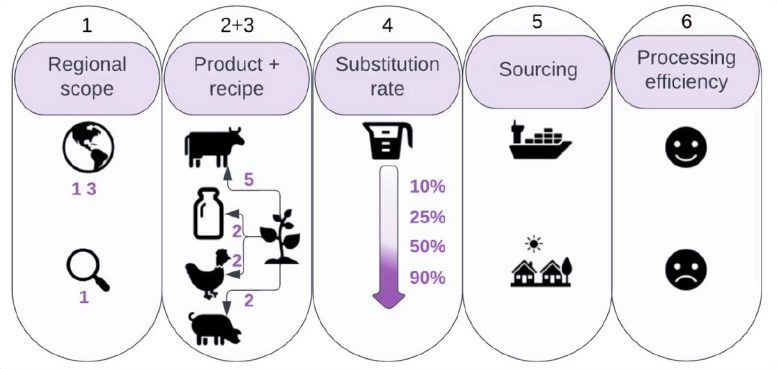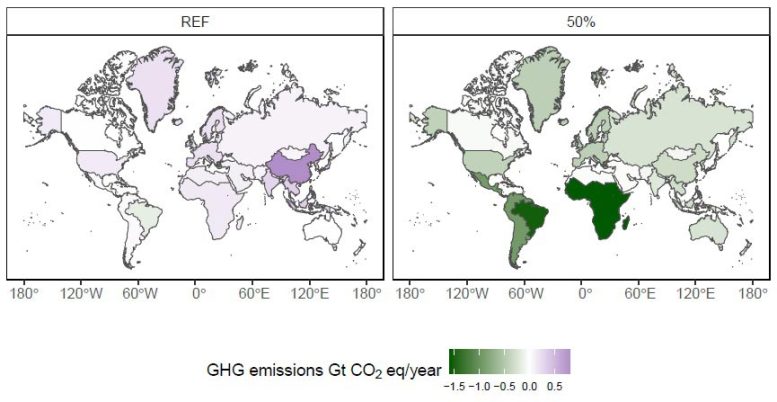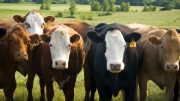
A research study suggests that transitioning from meat and milk products to plant-based alternatives can significantly improve climate and biodiversity outcomes. Reforesting land previously utilized for livestock can amplify these benefits.
Replacing 50% of meat and milk products with plant-based alternatives by 2050 can reduce agriculture and land use related greenhouse gas (GHG) emissions by 31% and halt the degradation of forest and natural land, according to new research.
According to the study published today (September 12) in the journal Nature Communications, additional climate and biodiversity benefits could accrue from reforesting land spared from livestock production when meat and milk products are substituted by plant-based alternatives, more than doubling the climate benefits and halving future declines of ecosystem integrity by 2050. The restored area could contribute up to 25% of the estimated global land restoration needs under Target 2 of the Kunming Montreal Global Biodiversity Framework by 2030.
About the Study
The study is the first to look at the global food security and environmental impacts of plant-based meat and milk consumption at large scales that considers the complexity of food systems. The research was conducted independently by IIASA in partnership with the Alliance of Bioversity and CIAT, as well as USAID, and solicited input from Impossible Foods – a company that develops plant-based substitutes for meat products – as a potential user of the data to ensure relevance. The company also provided generic recipes for the plant-based meat substitute products used in the analysis. The data are, however, not specific to Impossible Foods and the science team had complete control over decision-making.
“Understanding the impacts of dietary shifts expands our options for reducing GHG emissions. Shifting diets could also yield huge improvements for biodiversity,” notes study lead author Marta Kozicka, a researcher in the IIASA Biodiversity and Natural Resources Program.
“Plant-based meats are not just a novel food product, but a critical opportunity for achieving food security and climate goals while also achieving health and biodiversity objectives worldwide. Yet, such transitions are challenging and require a range of technological innovations and policy interventions,” adds study coauthor Eva Wollenberg from Alliance of Bioversity International and CIAT and the Gund Institute, University of Vermont.

Figure 1. The substitution in the scenarios of plant-based market development is defined along six dimensions: 1) regional scope (13 regions), 2) meat product (i.e., pork, chicken, milk, & beef), 3) recipe type (e.g., soy, pea, nut, etc.), 4) scenario substitution rate (10-19%), 5) international or domestic sourcing of ingredients, and 6) efficiency of converting crops into processed products. Credit: Kozicka, M., et al. (2023).
Scenarios and Findings
The authors developed scenarios of dietary changes based on plant-based recipes for beef, pork, chicken, and milk. The recipes were designed to be nutritionally equivalent to the original animal-derived protein products and realistic for the existing food manufacturing capabilities and globally available production ingredients (Figure 1).

Figure 2. Change in emissions between 2050 and 2020 from agricultural and land use. Sinks from land restoration were included in the total emissions calculation. REF presents the distribution of emissions in the reference scenario, while (50%) presents results under the 50% global substitution scenario. Credit: Kozicka, M., et al. (2023)
The authors found that a 50% substitution scenario would substantially reduce the mounting impacts of food systems on the natural environment by 2050 compared to the reference scenario (Figure 2). The impacts as compared to 2020 include:
- Global agricultural area declines by 12% instead of expanding.
- The decline in areas of forest and other natural land is almost completely halted.
- Nitrogen inputs to cropland are nearly half of the projections.
- Water use declines by 10% instead of increasing.
- Without accounting for any carbon sequestration on spared land, GHG emissions could decline by 2.1 Gt CO2eq year-1 (31%) in 2050 (1.6 Gt CO2eq year-1 on average in 2020–2050).
- Undernourishment globally declines to 3.6%, as compared to 3.8% in the reference scenario (reducing the number of undernourished people by 31 million).
Afforestation and Biodiversity
The full environmental benefit of diet shifts can be achieved if the agricultural land spared from livestock and feed production is restored through biodiversity-minded afforestation. In the 50% scenario, the benefits from reduced land-use emissions could double as compared to a scenario without afforestation – a total reduction of 6.3 Gt CO2eq year-1. At 90% substitution, the reduction of all agriculture and land-use emissions would increase to 11.1 Gt CO2eq year-1 in 2050.
The restoration of forest ecosystems would also improve biodiversity. The 50% scenario would reduce predicted declines in ecosystem integrity by more than half, while the 90% scenario could reverse biodiversity loss between 2030 and 2040.
“While the analyzed dietary shifts serve as a powerful enabler for reaching climate and biodiversity goals, they must be accompanied by targeted production side policies to deliver their full potential. Otherwise, these benefits will be partly lost due to production extensification and resulting GHG and land-use efficiency losses,” explains IIASA Biodiversity and Natural Resources Program Director Petr Havlík, who coordinated the study.
Regional Implications and Challenges
The study points out that impacts across regions could differ due to differences in population size and diets, unequal agricultural productivity, and participation in international trade of agricultural commodities. The main impacts on agricultural input use are in China and on environmental outcomes in Sub-Saharan Africa and South America. These regional differences could also be used to design better interventions.
“A global introduction of all novel alternatives has additional benefits compared to the scenarios with limited product or geographical scope, but regional substitution of specific products may be highly effective, especially if combined with regional strategies and purposeful selection of recipes,” Kozicka explains.
While the results support the increased use of plant-based meat substitutes, the authors recognize that livestock are a valuable source of income and nourishment for smallholders in low- and middle-income countries, and have significant cultural roles, reduce risk, and diversify smallholder income. Simultaneously, climate change threatens the livelihoods of smallholder farmers. Rapid policy and management action to avoid environmental risk and support farmers and other livestock value chain actors for a socially just and sustainable food system transition will therefore be crucial. This is particularly important considering recent setbacks to achieving food security globally.
Reference: “Feeding climate and biodiversity goals with novel plant-based meat and milk alternatives” by Marta Kozicka, Petr Havlík, Hugo Valin, Eva Wollenberg, Andre Deppermann, David Leclère, Pekka Lauri, Rebekah Moses, Esther Boere, Stefan Frank, Chris Davis, Esther Park and Noel Gurwick, 12 September 2023, Nature Communications.
DOI: 10.1038/s41467-023-40899-2









You can shove plant based meat up your ass.
There are major differences between plant and animal protein.
Humans need animal protein.
And lets not forget all these plant based meats are full of chemicals and beyond highly processed foods.
They are nothing but poison.
My daughter is a vegan who exclusively eats this crap and at 19 shes already having heart and health issues because of it.